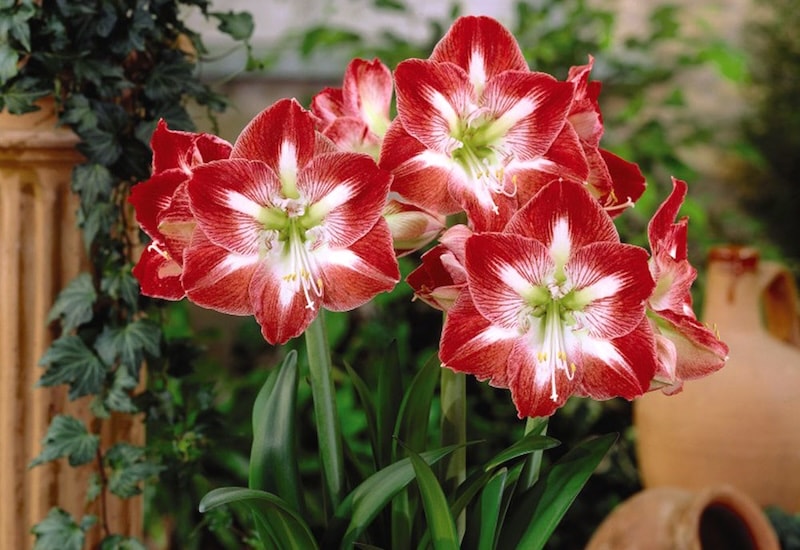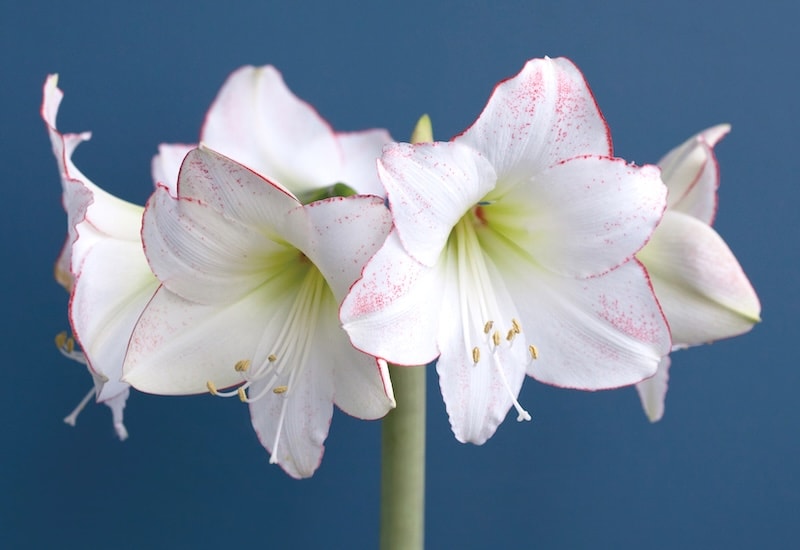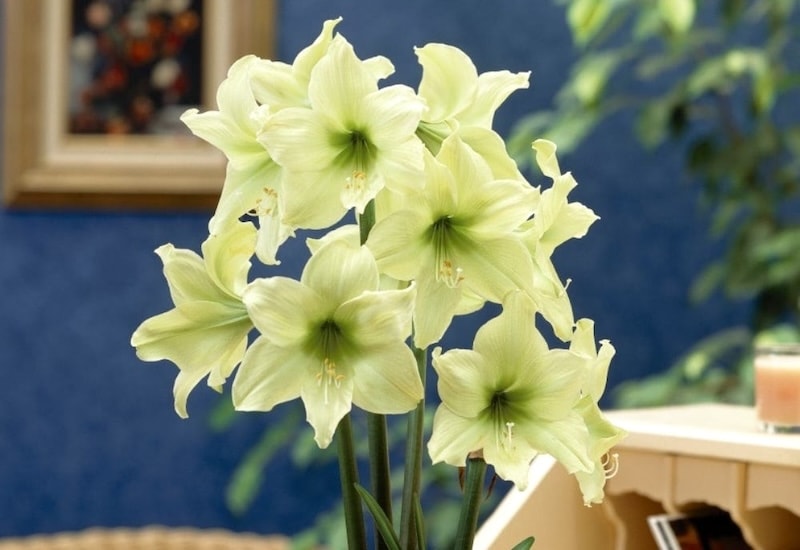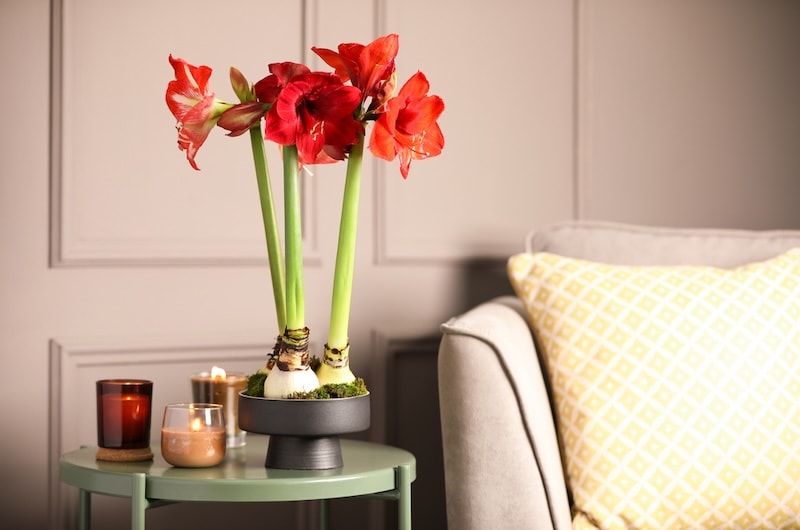Hippeastrum bulbs (commonly referred to as amaryllis) are grown as indoor plants in the UK and produce tall, show-stopping blooms through the winter. Planted from October to January, they take about 8 weeks to flower and are often timed so that they burst into bloom just before Christmas. If you’re looking for expert advice, here are some articles, YouTube videos and Instagram posts to help you grow amazing amaryllis displays.
In the meantime, see our full range of amaryllis bulbs for inspiration.
Contents:
- Best advice on how to plant amaryllis bulbs
- Best advice on how to get your amaryllis to flower again
- Best advice on caring for your amaryllis
Best advice on how to plant amaryllis bulbs

Image: Amaryllis ‘Minerva’ from Suttons/©Visions BV, Netherlands
Instead of encouraging her amaryllis to flower for Christmas, Marie Shallcross from Plew’s Garden Design looks forward to having the blooms in January “after all the decorations have been taken down and the house looks bare.” But do you know why these bulbs are known both as amaryllis and hippeastrums? Marie’s fascinating article explains that, although the correct botanical name is hippeastrum, “the common name ‘amaryllis’ continues to be used by plant nurseries, gardeners and the general public.” Whatever you call them, they’re definitely showstoppers, she adds.
“Count back eight weeks from the date you want your amaryllis to bloom and you’ll know exactly when to plant it,” recommends the horticultural team at Suttons. In their helpful guide to planting amaryllis bulbs, they also explain that this plant likes to be pot-bound, so you should choose a container that’s only just big enough for the bulb. And if you can, try to use containers with drainage, they say. “Although amaryllis needs to be kept moist, it really hates to be waterlogged.”
Planting your amaryllis bulb at the correct depth is very important, explains Annette from CottoVerdi. In her excellent video, she demonstrates how to sit the bulb in multi-purpose compost so that the top third is still visible, making it less likely to rot. She carefully backfills around the bulb with soil so that nothing falls into the growing tip, making sure that it’s anchored well enough to support the large, top-heavy blooms when they emerge. Annette gives her bulb a little water, before putting it in a bright, warm spot to sprout. Crucially, she says she won’t water it again until the active growth phase begins. Watch her full video for more tried and tested planting tips.
Katharine from The Tea Break Gardener chooses “fairly deep pots to encourage good root growth.” Once planted, she says that it might take a while for anything to happen, but “once it does, you’ll find the rate of growth of the flower stalk astounding, sometimes an inch or two a day.” At this point, she recommends turning your amaryllis every day to prevent the stalk from leaning towards the light. When the flowers emerge, she says that moving it to a cooler spot helps the blooms to last longer.
According to @jennyindigo, “sometimes nature is almost too astonishing!” This inspirational artist shares a glorious image of her own amaryllis in full bloom, set against a wonderful west-country backdrop. And if you needed any further reason to get planting, Jenny explains that, “in the Victorian language of flowers, amaryllis means ‘love, beauty, and determination’, and can also represent hope and achievement.” Follow her on Insta for a uniquely poetic view of the natural world around us.
Best advice on how to get your amaryllis to flower again

Image: Amaryllis Hippeas Picotee from Suttons
“Hippeastrums are perennials, so the bulbs can be regrown every year,” says Nick at UK Gardening. To get them to flower again, he snips the spent flower stems off at the base as they die, but keeps all the leaves which continue to grow through the summer. Once all danger of frost has passed, Nick moves his pots outside and “feeds once a week with a liquid fertiliser until late-summer”.
Over at Gardening at 58 North, Simon expertly demonstrates what to do when your amaryllis has finished flowering in his helpful video. Once the flowers have died, Simon gently pushes a stake into the pot and ties up the floppy leaves so they can each get plenty of light and air. Watch his video to learn how to look after the foliage through the summer to help your plant gather and return energy to the bulb.
If you want your hippeastrum to flower again, it’s vital that the bulb has a period of dormancy, explains Tom over at Our House Plants. To trigger this phase, he says you should stop feeding and watering the leaves at the end of summer and allow them to die back. Then move the bulb to “a cool but frost free place for around two months”. Tom explains that “the soil needs to be dry so don’t water at all during this time, or provide warmth.” Once the bulb has ‘rested’, you can start the cycle again by bringing it into a warm and bright room to wake it up. Read Tom’s full article for a great summary of the hippeastrum’s lifecycle.
Best advice on caring for your amaryllis

Image: Amaryllis Lemon Star from Suttons/©Visions BV, Netherlands
“Over-watering is the biggest issue with amaryllis,” says Joe Bagley from UK Houseplants. He explains that you’ll need to keep the soil moist if you want the flowers to last for a long time, but you should allow it to dry out between waterings “to prevent the chance of rot.” One of his top tips? “Remember to use tepid water to avert shocking the tender root systems.”
John Moore from Pyracantha says that there are several reasons why your amaryllis bulb might fail to flower. “If you put them somewhere far too shady without enough sunlight or warmth,” you may get fewer flowers or none at all. And if you underwater the plant during the previous summer while it’s returning energy to the bulb, it can also impact its ability to produce blooms. A word of warning from John: “If you put the containers outside for the summer, make sure you prevent slugs and snails from eating away at your plants.”
If your amaryllis leaves suddenly develop bright red patches or unusual variegation, your plants could be suffering from a fungal disease called red blotch, says Mandy over at MandyCanUDigIt. Also known as leaf scorch or red fire, she explains that it’s caused by the fungus Stagonospora curtisii that can be spread in cool, damp conditions. Read Mandy’s full article for tips on how to prevent and treat this disease. If you spot the signs in time, it doesn’t have to be fatal.
And finally, take a quick peek at this short Insta reel from Andy Trueman, a professional estate gardener who shares images from his home and work. Andy has condensed 6 weeks of growing into a fascinating video of less than 30 seconds, showing how his healthy amaryllis bulb bursts into life. Follow him over at @a_true_gardener for flower, vegetable and house plant inspiration.
We hope we’ve given you all the information you need to plant amaryllis bulbs and get them to flower again in subsequent years. Our article about the best festive house plants is full of interesting ideas and you can pick up advice on caring for your Christmas houseplants here.
Lead image: Shutterstock
Last Updated on November 21, 2024 by Suttons Horticultural Team






I have an Anaryillis in full bloom now. July 2024. Is this unusual?
I planted mine 2 years ago and it still giving me flowers. I was quite amazed when I went to get some soil that they were called Christmas plants. And they were even more amazed that I am still getting flowers. But I have not got leaves. So I am hoping I got the right plant.
I was gifted an amaryllis bulb for Christmas and planted it quite late in January. It’s just started blooming so this advice is much appreciated as I’m very keen for a repeat of this stunning display. Thank you.
Hi, need to know if Schultz-Instant liquid plant food 10-15-10 is ok to feed to amaryllis! This is my first time trying this and it is starting to grow. Don’t want to kill it. Very exciting to see it start growin!
HELP
Gail♀️♀️
Thanks for the info. Needed this !!